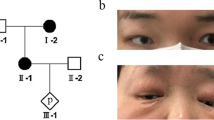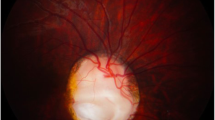Summary
Eleven patients with the so-called Cat Eye syndrome are reported including a more detailed description of the original cases reported by Schnid and Fraccaro. All cases had, in addition to a normal karyotype, a small extra G-like chromosome which appeared to be an isochromosome for the juxtacentromeric region (pter→q11) of an acrocentric chromosome. None were mosaics. Clinical findings and further cytogenetic studies in a few cases suggest that these markers probably derive from a No. 22 chromosome.
Characteristic features of the Cat Eye syndrome in these 11 patients and those reviewed from the literature are: ocular coloboma which may involve the iris, choroid and/or optic nerve, preauricular skin tags and/or pits which are probably the most consistent feature, congenital heart defect, anal atresia with a fistula, renal malformations such as unilateral absence, unilateral or bilateral hypoplasia, and cystic dysplasia, and antimongoloid position of eyes. Intelligence is usually low-normal, although moderate retardation is also seen. There is great variability in the clinical findings ranging from near normal to lethal malformations. Less frequent, but also characteristic findings are: microphthalmia, microtia with atresia of the external auditory canal, intrahepatic or extrahepatic biliary atresia and malrotation of the gut.
Direct transmission of the marker from one generation to the other was observed in both sexes. In those families, there was considerable variability in the clinical findings between affected family members. Theses cases show that there is a bias of ascertainment for patients who have the more striking malformation, especially those with ocular coloboma and anal atresia, a combination which appears to be present in only a minority of cases. Many mildly affected patients probably remain undetected.
It is proposed that the term Cat Eye syndrome should be applied only to cases with trisomy or tetrasomy of not more than 22pter→q11 and without additional duplication or deletion of another autosomal segment.
Similar content being viewed by others
References
Abe T, Morita M, Kawai K, Misawa S, Takino T, Hashimoto H, Nakagome Y (1977) Partial tetrasomy 9 (9pter→-9q2101) due to an extra iso-dicentric chromosome. Ann Génét 20:111–114
Allderdice, PW, Miller OJ, Miller DA, Breg WR, Gendel E, Zelson C (1971) Familial translocation involving chromosomes 6, 14, and 20, identified by Quinacrine fluorescence. Humangenetik 13:205–209
Al Saadi A, Yang SS, Singla P (1977) Partial trisomy of chromosomes 22 and 16 in a microphathalmic infant. Am J Hum Genet 29: 18A
Balci S, Halicioglu C, Say B, Taysi K (1974) The cat-eye syndrome with unusual skeletal malformations. Acta Paediatr Scand 63:623–626
Bannister DL, Engel E (1975) A G-like trisomy with a major 15 proximal component derived from a D/E balanced maternal interchange. J Pediat 86:916–917
Beyer P, Ruch JV, Rumpler Y, Girard J (1968) Observation d'un enfant débil mental et polymalformé dont le caryotype montre la présence d'un extrachromosome médiocentrique. Pédiatrie 33:439–442
Borgaonkar DS, McKusick VA, Farber PA (1973) An inherited small extra chromosome. a mother with 46,XX,t(17;22)(p1;q1) and a son with 47,XY,+der(22)mat. J Med Genet 10:379–384
Bühler EM, Méhes K, Müller H, Stalder GR (1972) Cat-eye syndrome a partial trisomy 22. Humangenetik 15:150–162
Carmi R, Abeliovich D, Bar-Ziv J, Karplus M, Cohen MM (1980) Malformation syndrome associated with small extra chromosome. Am J Med Genet 5:101–107
Castel Y, Ribière D, Boucly JY, Toudic L (1976) Trisomie 15q partielle par translocation maternelle t(7;15)(q35;q14). Ann Génét 19: 75–79
Coco R, Penchaszadeh VB (1977) Partial trisomy 14q and familial translocation (2;14)(q12;q13). Ann Génét 20:41–44
Cohen MM, Ornoy A, Rosemann A, Kohn G (1975) An inherited translocation t(4;15)(p16;q22) leading to two cases of partial trisomy 15. Ann Génét 18:99–103
Cory CC, Jamison DL (1974) The cat eye syndrome. Arch Ophthalmol 92:259–262
Darby CW, Hughes DT (1971) Dermatoglyphics and chromosomes in cat-eye syndrome. Brit Med J 3:47–48
Escobar JI, Yunis JJ (1974) Trisomy for the proximal segment of the long arm of chromosome 13. A new entity? Am J Dis Child 128: 221–222
Fawcett WA, McCord WK, Francke U (1975) Trisomy 14q-. Birth Defects. Orig Art Ser XI:223–228
Ferrandez A, Schmid W (1971) Potter-Syndrom (Nierenagenesie) mit chromosomaler Aberration beim Patient und Mosaik beim Vater. Helv Pacdiatr Acta 26:210–214
Fryns JP, Eggermont E, Verresen H, Van den Berghe H (1972) A newborn with the cat-eye syndrome. Humangenetik 15:242–248
Fryns JP, Cassiman JJ, Van den Berghe H (1974) Tertiary partial 14 trisomy, 47, XX,+14q-. Humangenetik 24:71–77
Fujimoto A, Towner JW, Ebbin AJ, Kahlstrom EJ, Wilson MG (1974) Inherited partial duplication of chromosome No. 15. J Med Genet 11:287–291
Garlinger P, McGeary SA, Magenis E (1977) Partial trisomy 22: a recognizable syndrome. Clin Genet 12:9–16
Geneix A, Jaffray JY, Malet P, Foulon E, Jalbert P, Crost P (1979) A new case of partial trisomy 15q-. Hum Genet 51:335–338
Gerald PS, Davis C, Say B, Wilkins J (1972) Syndromal association of imperforate anus: the cat eye syndrome. Birth Defects, Orig Art Ser XIII:79–84
Ginsberg J, Dignan P, Soukup S (1968) Ocular abnormality associated with extra small autosome. Am J Ophthalmol 65:740–746
Giorgi PI, Tarantino E, Formica A, Dallapiccola B (1979) Trisomia parziale terziaria 14(pter→q21) da traslocazione familiare t(10;14) (p15.2;q21). Acta Med Auxol 11:61–65
Giraud F, Mattei JF, Hartung M, Mattei MG (1975) Petit chromosome submétacentrique surnuméraire et syndrome des yeux de chat. Ann Pédiat 22:449–452
Kaye CI, Booth CW, Meekr D, Nadler HL (1977) Cleft palate and multiple anomalies in one of two siblings with partial 13 trisomy. Cleft Palate J 14:244–248
Kovacs G, Mihai C (1979) Tertiary trisomy 14q- due to paternal balanced translocation 46,XY,t(1;14)(q44;q22). Hum Genet 49: 175–178
Krmpotic E, Rosnick MR, Zollar ML (1971) Genetic counseling. Secondary nondisjunction in partial trisomy 13. Obstet Gynecol 37: 381–390
Kunze J, Tolksdorf M, Wiedemann HR (1975) Cat Eye-Syndrom. Klinische und cytogenetische Differentialdiagnose. Hum Genet 26: 271–289
Macintyre NM, Walden DB, Hempel JM (1971) Tertiary trisomy in a human kindred containing a E/G translocation. Am J Hum Genet 23:431–441
Macintyre NM, Hempel JM, Walden DB, Miller RC, Greene AE, Coriell LL (1975) A (17;22) translocation, balanced, 46 chromosomes. Repository identification No. GM-119. Cytogenet Cell Genet 14: 80–81
Moedjono SJ, Sparkes RS (1979) Partial trisomy of 13 (pter q12) due to 47,XY,+der(13),t(13;22)(q12;q13) mat. Hum Genet 50:241–246
Monteleone PL, Monteleone JA, Grzegocki J (1969) An unusual balanced reciprocal translocation in several members of a family. J Med Genet 6:394–398
Niermeijer MF, Sachs ES, Johodova M, Tichelaar-Klepper C, Kleijer WJ, Galjaard H (1976) Prenatal diagnosis of genetic disorders. J Med Genet 13:182–194
Noel B, Quack B (1970) Petit métacentrique surnuméraire chez un polymalformé. J Génét Hum 18:45–56
Noel B, Ayraud N, Levy M, Cau D (1976a) Le syndrome des yeux de chat. Etude chromosomique et conseil génétique. J Génét Hum 24: 279–291
Noel B, Quack B, Rethoré MO (1976b) Partial deletions and trisomies of chromosome 13; mapping of bands associated with particular malformations. Clin Genet 9:593–602
Pena SDJ, Ray M, McAlpine PJ, Ducasse C, Briggs J, Hamerton J (1976) Tertiary trisomy 14: is there a syndrome?. Birth Defects. Orig Art Ser XII:113–118
Petit P, Godard S, Fryns JP (1980) Silver staining of the supernumerary chromosome in the cat-eye syndrome. Ann Génét 23:114–116
Pfeiffer RA, Heimann K, Heiming E, Schlack H, Maul H (1971) Kolobom and analatresie: Phänotyp einer Chromosomenaberration? Klin Monatsbl Augenheilk 159:357–367
Pfeiffer RA, Kessel E (1976) Partial trisomy 15q1. Hum Genet 33:77–83
Pierson M, Gilgenkrantz S, Saborio M (1975) Syndrome dit de l'oeil de chat avec nanisme hypophysaire et développement mental normal. Arch Fr Pédiatr 32:835–848
Primarosa de Chieri R, Malfatti C, Stanchi F, Albores JM (1974) Cat-eye syndrome: evaluation of the extra chromosome with banding techniques. J Génét Hum 22:101–107
Raoul O, Rethoré MO, Dutrillaux B, Michon L, Lejeune J (1975) Trisomie 14q partielle. I. Trisomie 14q partielle par translocation maternelle t(10;14)(p15.1;q22). Ann Génét 18:35–39
Reiss JA, Wyandt HF, Magenis RE, Lovrien EW, Hecht F (1972) Mosaicism with translocation: autoradiographic and fluorescent studies of an inherited reciprocal translocation t(2q+;14q-). J Med Genet 9:280–286
Rethoré MO, Dutrillaux B, Lejeune J (1973) Translocation 46,XX, t(15;21)(q13;q22.1) chez la mère de deux enfants atteints de trisomie 15 et de monosomie 21 partielles. Ann Génét 16:271–275
Schachenmann G, Schmid W, Fraccaro M, Mannini A, Tiepolo L, Perona GP, Sartori E (1965) Chromosomes in coloboma and anal atresia. Lancet 2:290
Schinzel A (1981a) Incomplete trisomy 22. II. Familial trisomy of the distal segment of chromosome 22q in two brothers from a mother with a translocation, t(6;22)(q27;q13). Hum Genet 56:263–268
Schinzel A,(1981b) Incomplete trisomy 22. III. Mosaic-trisomy 22 and the problem of full trisomy 22. Hum Genet 56:269–273
Schinzel A, Schmid W, Mürset G (1974) Different forms of incomplete trisomy 13. Mosaicism and partial trisomy for the proximal and distal long arm. Report of three cases. Humangenetik 22:287–298
Schinzel A, Schmid W, Auf der Maur P, Moser H, Degenhardt KH, Geisler M, Grubisic A (1981) Incomplete trisomy 22. I. Familial 11/22 translocation with 3:1 meiotic disjunction. Delineation of a common clinical picture and report of 9 new cases from 6 families. Hum Genet 56:249–262
Schmid W (1967) Pericentric inversions. report of two malformation cases suggestive of parental inversion heterozygosity. J Génét Hum 16:89–96
Schwanitz G, Grosse KP, Semmelmayer U, Mangold H (1974) Partielle freie Trisomie 13 in einer Familie mit balancierter Translocation (13q-;16q+). Monatsschar Kinderheilk 122:337–342
Short EM, Solitare GB, Breg WR (1972) A case of partial 14 trisomy 47,XY,(14q-)+ and a translocation t(9p+;14q-) in mother and brother. J Med Genet 9:367–373
Simpson J, Zellweger H (1977) Partial trisomy 14q- and parental translocation of No. 14 chromosome. J Med Genet 14:124–127
Surana RB, Conen PE, Braudo M, Keith JD (1974) Familial tertiary trisomy with t(14q-;1+?). Birth Defects. Orig Art Ser X:53–65
Toomey KE, Mohandas T, Leisti J, Szalay G, Kaback MM (1977) Further delineation of the supernumerary chromosome in the cat eye syndrome. Clin Genet 12:275–284
Tsipouras P, Vekemans M, Rudner M (1979) Tertiary trisomy for the proximal part of the long arm of chromsome 13. Am J Hum Genet 31:113A
Turleau C, de Grouchy J, Bocquentin F, Roubin M, Chavin-Colin F (1975) Trisomie 14q partielle. II. Trisomie 14q partielle par translocation maternelle t(12;14)(q24.4;q21). Ann Génét 18:41–44
Weber FM, Dooley RR, Sparkes RS (1970) Anal atresia, eye anomalies, and an additional small abnormal acrocentric chromosome (47,XX, mar+). Report of a case. J Pediatr 76:594–597
Weleber RG, Walknowska J, Peakman D (1977) Cytogenetic investigation of the cat-eye syndrome. Am J Ophthalmol 84:477–486
Wisniewski L, Hasold T, Heffelfinger J, Higgins JV (1979) Cytogenetic and clinical studies in five cases of inv dup(15). Hum Genet 50:259–270
Young SR, Donovan DM, Greer HA, Burch K, Potter DC (1976) Tertiary trisomy, 47,XX,+14q-, resulting from material balanced translocation, 46,XX,t(14;16)(q11;q24). Hum Genet 33:331–334
Zannotti M, del Po A, Forabosco A, Rossi-Giovanardi P (1977) Cromosoma i dic(15q) sopranumerario in un soggetto con ritardo mentale. Acta Med Auxol 9:177–178
Author information
Authors and Affiliations
Rights and permissions
About this article
Cite this article
Schinzel, A., Schmid, W., Fraccaro, M. et al. The “Cat Eye syndrome”: Dicentric small marker chromosome probably derived from a No. 22 (Tetrasomy 22pter→q11) associated with a characteristic phenotype. Hum Genet 57, 148–158 (1981). https://doi.org/10.1007/BF00282012
Received:
Issue Date:
DOI: https://doi.org/10.1007/BF00282012




